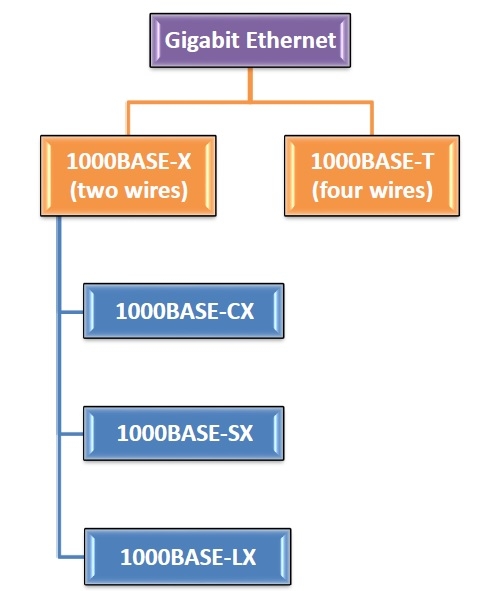
 Data Structure
Data Structure Networking
Networking RDBMS
RDBMS Operating System
Operating System Java
Java MS Excel
MS Excel iOS
iOS HTML
HTML CSS
CSS Android
Android Python
Python C Programming
C Programming C++
C++ C#
C# MongoDB
MongoDB MySQL
MySQL Javascript
Javascript PHP
PHPPhysics
Chemistry
Biology
Mathematics
English
Economics
Psychology
Social Studies
Fashion Studies
Legal Studies
- Selected Reading
- UPSC IAS Exams Notes
- Developer's Best Practices
- Questions and Answers
- Effective Resume Writing
- HR Interview Questions
- Computer Glossary
- Who is Who
Gigabit Ethernet
In computer networks, Gigabit Ethernet (GbE) is the family of Ethernet technologies that achieve theoretical data rates of 1 gigabit per second (1 Gbps). It was introduced in 1999 and was defined by the IEEE 802.3ab standard.
Varieties of Gigabit Ethernet
The popular varieties of fast Ethernet are 1000Base-SX, 1000Base-LX, 1000BASE-T and 1000Base-CX.

1000BASE-CX
- Defined by IEEE 802.3z standard
- The initial standard for Gigabit Ethernet
- Uses shielded twisted pair cables with DE-9 or 8P8C connector
- Maximum segment length is 25 metres
- Uses NRZ line encoding and 8B/6B block encoding
1000BASE-SX
- Defined by IEEE 802.3z standard
- Uses a pair of fibre optic cables of a shorter wavelength having 770 – 860 nm diameter
- The maximum segment length varies from 220 – 550 metres depending upon the fiber properties.
- Uses NRZ line encoding and 8B/10B block encoding
1000BASE-LX
- Defined by IEEE 802.3z standard
- Uses a pair of fibre optic cables of a longer wavelength having 1270 – 1355 nm diameter
- Maximum segment length is 500 metres
- Can cover distances up to 5 km
- Uses NRZ line encoding and 8B/10B block encoding
1000BASE-T
- Defined by IEEE 802.3ab standard
- Uses a pair four lanes of twisted-pair cables (Cat-5, Cat-5e, Cat-6, Cat‑7)
- Maximum segment length is 100 metres
- Uses trellis code modulation technique

Advertisements
